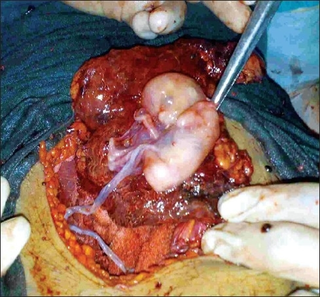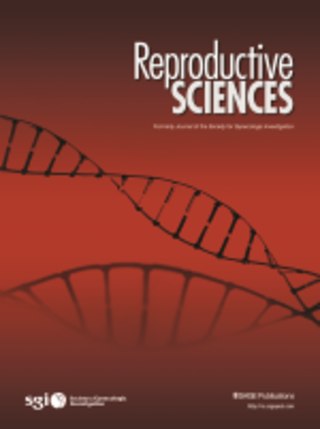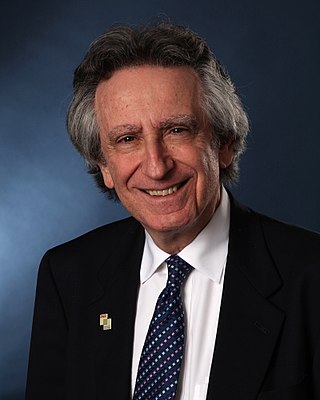
Asherman's syndrome (AS) is an acquired uterine condition that occurs when scar tissue (adhesions) forms inside the uterus and/or the cervix. It is characterized by variable scarring inside the uterine cavity, where in many cases the front and back walls of the uterus stick to one another. AS can be the cause of menstrual disturbances, infertility, and placental abnormalities. Although the first case of intrauterine adhesion was published in 1894 by Heinrich Fritsch, it was only after 54 years that a full description of Asherman syndrome was carried out by Joseph Asherman. A number of other terms have been used to describe the condition and related conditions including: uterine/cervical atresia, traumatic uterine atrophy, sclerotic endometrium, and endometrial sclerosis.
In biology and medicine, gravidity and parity are the number of times a female has been pregnant (gravidity) and carried the pregnancies to a viable gestational age (parity). These two terms are usually coupled, sometimes with additional terms, to indicate more details of the female's obstetric history. When using these terms:

An abdominal pregnancy is a rare type of ectopic pregnancy where the embryo or fetus is growing and developing outside the uterus, in the abdomen, and not in a fallopian tube, an ovary, or the broad ligament.
Mirror syndrome, triple edema or Ballantyne syndrome is a rare disorder affecting pregnant women. It describes the unusual association of fetal and placental hydrops with maternal preeclampsia.
Reproductive endocrinology and infertility (REI) is a surgical subspecialty of obstetrics and gynecology that trains physicians in reproductive medicine addressing hormonal functioning as it pertains to reproduction as well as the issue of infertility. While most REI specialists primarily focus on the treatment of infertility, reproductive endocrinologists are trained to also test and treat hormonal dysfunctions in females and males outside infertility. Reproductive endocrinologists have specialty training (residency) in obstetrics and gynecology (ob-gyn) before they undergo sub-specialty training (fellowship) in REI.
Reproductive surgery is surgery in the field of reproductive medicine. It can be used for contraception, e.g. in vasectomy, wherein the vasa deferentia of a male are severed, but is also used plentifully in assisted reproductive technology. Reproductive surgery is generally divided into three categories: surgery for infertility, in vitro fertilization, and fertility preservation.
The following outline is provided as an overview of and topical guide to obstetrics:

Mark V. Sauer is an American physician who specializes in reproductive medicine. He is a clinician, researcher and medical educator best known for his work in the development of egg and embryo donation, fertility care of HIV-seropositive patients, and reproductive bioethics. He currently is Professor and Chairman of Obstetrics, Gynecology and Reproductive Sciences at Rutgers Robert Wood Johnson Medical School in New Brunswick, New Jersey. He also serves as the Senior Associate Dean for Women's Health there. Sauer was the Chief of the Division of Reproductive Endocrinology at Columbia University Medical Center in New York City for twenty-one years, where he was also the program and laboratory director of the Center for Women's Reproductive Care, and a tenured professor and vice-chairman in the Department of Obstetrics and Gynecology at the College of Physicians and Surgeons, Columbia University. While at Columbia University he also served on the Medical Ethics Committee of New York Presbyterian-Columbia University Medical Center.

Human Reproduction is a peer-reviewed scientific journal covering all aspects of human reproduction, including reproductive physiology and pathology, endocrinology, andrology, gonad function, gametogenesis, fertilization, embryo development, implantation, pregnancy, genetics, preimplantation genetic diagnosis, oncology, infectious disease, surgery, contraception, infertility treatment, psychology, ethics, and social issues. It is an official journal of the European Society of Human Reproduction and Embryology. It was established in 1986 with Robert Edwards as founding editor-in-chief.

Genesis: The Journal of Genetics and Development is a peer-reviewed scientific journal of genetics and developmental biology. It was established as Developmental Genetics in 1979 and obtained its current title in 2000. In addition to original research articles, the journal also publishes letters to the editor and technology reports relevant to the understanding of the functions of genes. The editor-in-chief is Sally A. Moody.

Reproductive Sciences is a peer-reviewed medical journal that publishes papers in the fields of obstetrics and gynecology. The co-editors-in-chief are Ayman Al-Hendy and Seung-Yup Ku. It was established in 1994 and is currently published by Springer Nature on behalf of the Society for Reproductive Investigation.
Contraception is a monthly peer-reviewed medical journal covering reproductive medicine. It is published by Elsevier and was established in 1970. It is the official journal of the Association of Reproductive Health Professionals and the Society of Family Planning. The founding editor-in-chief was Daniel R. Mishell, Jr. and the current one is Carolyn Westhoff. According to the Journal Citation Reports, the journal has a 2014 impact factor of 2.335, ranking it 23rd out of 79 journals in the category "Obstetrics & Gynecology".
Friday OkonofuaFAS is a Nigerian professor of Gynecology and Obstetrics. He is the pioneer Vice Chancellor of Ondo State University of Medical Sciences and founder of Women Health and Action Research Centre, a not-for-profit organization headquartered in Benin City, that focuses on promoting female reproductive research.
Alan H. DeCherney is an Obstetrician and Gynecologist who specializes in reproductive endocrinology & infertility. He is experienced in reproductive and endocrinology, infertility, and reproductive genetics.

Marek Glezerman is an Israeli obstetrician and gynecologist, Professor Emeritus of Obstetrics and Gynecology, head of Gender and Sex Conscious Medicine and immediate past chair of the Ethics Committee at the Faculty of Medicine, Tel Aviv University. He is the founding president of The Israel Society for Gender and Sex Conscious Medicine and past president of the International Society of Gender Medicine. Glezerman is also a member of the Ministry of Health's National Council for Obstetrics and Gynecology, Genetics and Perinatology. Prof. Glezerman is internationally considered one of the pioneers of Gender and Sex Conscious Medicine.

Eli Y. Adashi is an American physician and scientist who served as the Fifth Dean of Medicine and Biological Sciences at Brown University. Adashi is presently a tenured Professor of Medical Science with the Warren Alpert Medical School of Brown University. He is a member of the National Academy of Medicine, the New York Academy of Sciences, and the Association of American Physicians (AAP). Adashi is also a fellow of the American Association for the Advancement of Science (AAAS), the Hastings Center Ethics Research Institute, and the Royal Society of Medicine.
Norbert Gleicher is an American obstetrician-gynecologist active in obstetrical practice, in vitro fertilization, reproductive endocrinology, and reproductive immunology. He is a fellow of the American College of Obstetricians and Gynecologists (FACOG) and the American College of Surgeons (ACS) and currently serves as president, medical director and chief scientist of the Center for Human Reproduction (CHR) in New York City, a clinical fertility center that he founded in 1981. Simultaneously, he is President of the Foundation for Reproductive Medicine, a not-for-profit research foundation. Gleicher maintains additional academic appointments at Rockefeller University, and Medical University of Vienna.
Joseph C. Gambone is an osteopathic physician, clinical professor at Western University of Health Sciences, and emeritus professor of obstetrics and gynecology at University of California, Los Angeles (UCLA). Gambone is the Executive Editor of the textbook Essentials of Obstetrics and Gynecology. He currently practices reproductive endocrinology and infertility in Durango, Colorado. A former Lieutenant in the US Navy, Gambone Peak in Antarctica was named in his honor.
Beryl Rice Benacerraf was an American radiologist and professor of obstetrics, gynecology and reproductive biology and radiology at Harvard Medical School. She was a pioneer in the use of prenatal ultrasound to diagnose fetal abnormalities, including Down syndrome. In 2021, she was recognized as a "Giant in Obstetrics and Gynecology" by the American Journal of Obstetrics & Gynecology.







